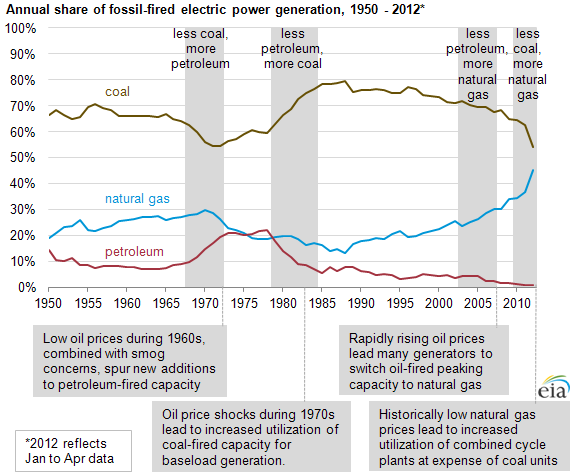
Competition among fuels for power generation driven by changes in fuel prices

Notes: Shares are calculated using generation supplied by all sectors. Data for 2012 include January through April. Start and end years for the grey boxes are approximate. A very small percentage (generally less than 0.5%) of fossil-fired generation is from other gases, not shown.
The mix of fuels used to generate electricity has varied over time. Several factors, especially changes in relative fossil fuel prices, have influenced the mix of energy sources used. EIA recently released a study on the competition between coal, natural gas, and petroleum used for electricity generation, which estimates what economists refer to as the elasticity of substitution among the fuels. The 'elasticity of substitution' concept measures how the use of these fuels varies as their relative prices change.
The structure of the power industry varies from region to region. Generation dispatch decisions are made by an individual utility operating multiple plants in its service area or by a Regional Transmission Organization as part of a centralized wholesale power market. In either case, generation costs are a primary driver determining the mix of fuels used to supply a region's power load.
As fuel costs and technology change over time, some energy sources become more economical to use than others. Historically, coal and nuclear generation units supplied most of the baseload power demand in the United States partly because of their low fuel-related operating costs. Generation fueled by natural gas and petroleum supplemented the baseload generators during peak and intermediate periods of demand. In some areas of the country, abundant hydropower capacity has supplied both baseload and peaking generation. Fossil fuels—coal, natural gas, and petroleum—supplied 70% of total electric power generation in 1950, with that share rising to 82% in 1970, and falling back to 70% in 2010.
Although coal has been the predominant fuel used in power generation in the U.S. over the last 60 years, its share of the fossil fuel mix has varied in response to changes in the cost and availability of competing fuels. There have been some periods when volatility in fuel costs have had especially strong impacts on the mix of fuels used for generation:
- During the late 1960s, concerns about emissions from coal-fired power plants drove an increase in petroleum-fired generation capacity. Low and stable crude oil prices during the 1960s provided further stimulus to the shift from coal- to petroleum-fired generation.
- Two oil price shocks during the 1970s, the Powerplant and Industrial Fuel Use Act of 1978, (PIFUA) and a large build-out of new coal capacity in the 1970s and 1980s contributed to a shift away from petroleum and back to coal for baseload power generation.
- By 1990, PIFUA had been repealed and the natural gas markets had been deregulated, allowing more opportunities for substitution between petroleum and natural gas as a fuel for peaking generation. Petroleum-fired plants in particular were limited by environmental regulations on emissions.
- Most recently, a number of factors have led to a continuing electric power industry trend of substituting coal-fired generation with natural gas-fired generation: During the 1990s and 2000s, the cost of natural gas generation decreased with the increased use of efficient combined cycle technology for power generation. Expansion of the natural gas pipeline network decreased uncertainties around natural gas availability. Natural gas production gains from domestic shale gas formations began to rapidly increase starting in 2005. Rising shale natural gas production outpaced natural gas demand growth and contributed to falling natural gas prices, while coal prices rose. Starting in 2009, these trends began to alter the relative economics affecting the dispatch of generators relying on Appalachian coal and natural gas, in the eastern half of the country.
Factors other than fuel prices played important roles in determining which power plants are run to meet electricity demand. One important factor is the availability of generating capacity. Between 2000 and 2012, natural gas generating capacity grew by 96%. In contrast, additions to coal capacity were relatively minor during that period, and petroleum-fired capacity declined by 12%. Other factors include: generators' nonfuel variable operating costs, startup/shut down costs, emission rates and allowance costs, transmission constraints on the electricity grid, and reliability requirements. Electricity system operators evaluate all of these factors when determining which plants and fuels to use.
Earlier academic studies analyzed fossil fuel substitution, largely between natural gas and petroleum, during the period of the 1980s and 1990s. EIA's recent report updates these earlier elasticity studies to reflect recent dispatching patterns during a period of increasing competition between natural gas and coal (2005-2010). EIA's study indicates that for the United States as a whole, a 10% increase in the ratio of the delivered fuel price of coal to the delivered price of natural gas leads to a 1.4% increase in the use of natural gas relative to coal. The elasticity estimates are most robust for the southeastern United States, while results for the Midwest and Texas are relatively insignificant. For more analysis and complete results, see the full report.